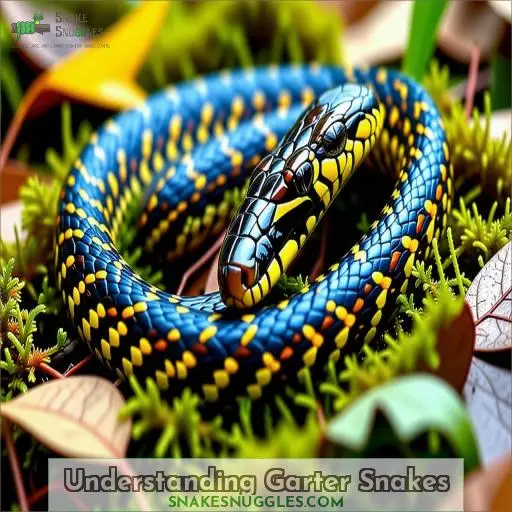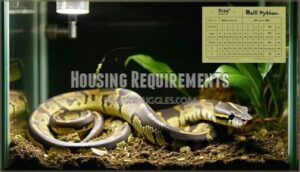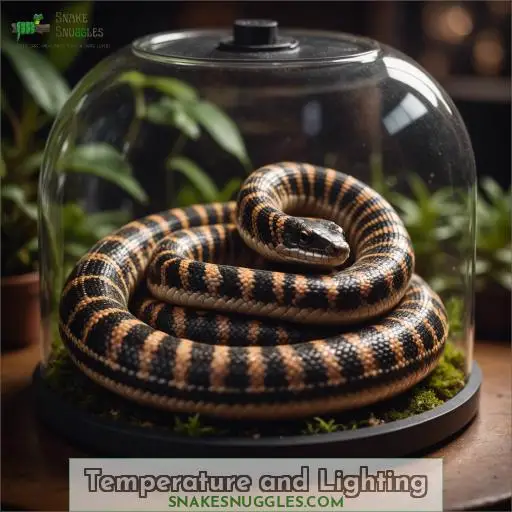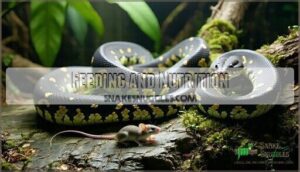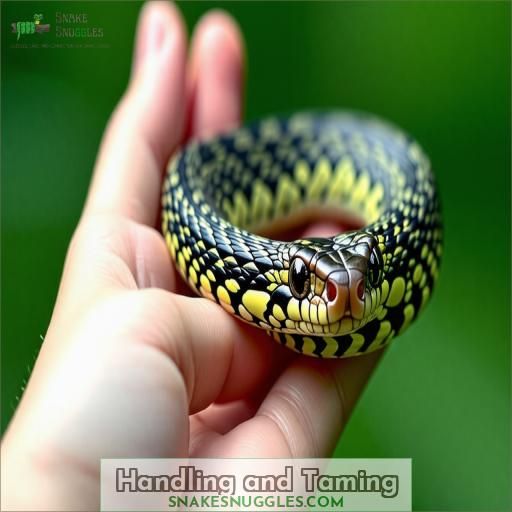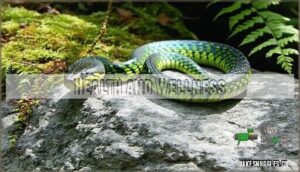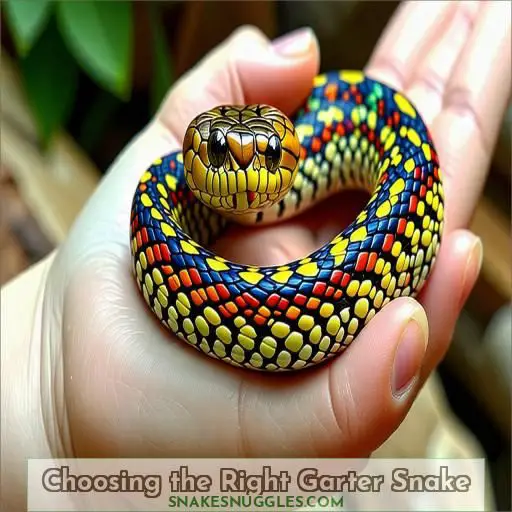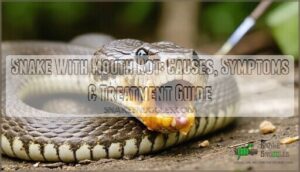This site is supported by our readers. We may earn a commission, at no cost to you, if you purchase through links.
 Caring for garter snakes begins with understanding their needs. You’ll need a secure enclosure with proper substrate, hiding spots, and a temperature gradient with basking and cool zones. Maintain 40-60% humidity and provide a large water bowl.
Caring for garter snakes begins with understanding their needs. You’ll need a secure enclosure with proper substrate, hiding spots, and a temperature gradient with basking and cool zones. Maintain 40-60% humidity and provide a large water bowl.
Feed appropriately sized prey every 5-7 days, supplemented with calcium. Monitor for health issues like respiratory infections and parasites. Proper handling minimizes stress.
During brumation, gradually cool them to 40-55°F for 2-3 months. With the right setup and care routine, these adaptable snakes can thrive in captivity.
Of course, explore further for an extensive guide to uncover all the details.
Table Of Contents
- Key Takeaways
- Understanding Garter Snakes
- Housing Requirements
- Temperature and Lighting
- Water and Humidity
- Feeding and Nutrition
- Handling and Taming
- Health and Wellness
- Brumation and Breeding
- Choosing the Right Garter Snake
- Frequently Asked Questions (FAQs)
- Are garter snakes hard to take care of?
- Is it OK to keep a garter snake as a pet?
- What do garter snakes need in their tank?
- Do garter snakes like to be held?
- How to breed garter snakes at home?
- Can garter snakes be housed together?
- Are there any special considerations for garter snake lighting?
- What are the common health issues in garter snakes?
- How can I tell if my garter snake is stressed?
- Conclusion
Key Takeaways
- Provide a secure enclosure with proper substrate, hiding spots, temperature gradient, and humidity levels to meet their environmental needs
- Feed appropriately sized prey every 5-7 days, supplemented with calcium and vitamins to ensure proper nutrition
- Handle gently, limit stress, and monitor for health issues like respiratory infections and parasites to maintain their well-being
- Gradually cool them to 40-55°F for 2-3 months during brumation to facilitate breeding and reset feeding cycles
Understanding Garter Snakes
Garter snakes comprise a diverse genus, Thamnophis, encompassing numerous species and subspecies found across North and Central America. Understanding their natural habitats, behaviors, and temperaments is essential for providing appropriate care customized to the specific species or subspecies you plan to keep.
Species and Subspecies
Garter snakes exhibit remarkable color variations, with patterns ranging from solid hues to intricate stripes and checkered designs. These reptiles’ diverse subspecies reflect their evolutionary history and regional adaptations across North and Central America.
Habitat and Distribution
Garter snakes thrive in diverse North American habitats, from fields and forests to wetlands and even urban areas. Their seasonal migrations and adaptability pose conservation challenges as urbanization threatens their natural environments.
Behavior and Temperament
Garter snakes are generally docile but can become defensive if stressed. Regular, gentle handling helps them become tame. Avoid excessive handling, especially after feeding. Signs of stress include musking, biting, or excessive hiding .S
ome key points about garter snake behavior and temperament:
- Captive-bred garter snakes tend to be calmer than wild-caught individuals (Source).
- Frequent, positive interactions help snakes become accustomed to handling and build trust .
- Provide hiding spots to make snakes feel secure and reduce stress .
- Avoid handling after feeding to prevent regurgitation and stress .
Housing Requirements
When selecting an enclosure for your garter snake, opt for a secure tank or terrarium that provides ample floor space for the snake’s length, allowing for a thermal gradient and adequate hiding spots.
The substrate should be easy to spot-clean, moisture-retentive for maintaining proper humidity levels, and offer opportunities for burrowing through the use of options like coconut fiber, cypress mulch, or reptile carpet.
Enclosure Size and Type
For housing garter snakes, choose an escape-proof tank over a tub. Ideal tank height varies by species. Regular tank cleaning is vital, with a recommended frequency of weekly to bi-weekly depending on group size. Guarantee humidity, water, and feeding are well-maintained.
Substrate Options
Provide a 2-4 inch layer of aspen shavings or cypress mulch to encourage natural digging behaviors and retain humidity. Spot clean regularly and fully replace every 2-3 months to prevent odor, mold, and bacteria buildup from food and waste.
Hiding Spots and Enrichment
Provide your garter snake with a variety of hide types, such as overturned pots and slates, placed in both warm and cool areas. Incorporate enrichment like branches and plants to encourage natural behaviors and reduce stress.
Temperature and Lighting
Providing the proper temperature gradient is essential for your garter snake’s well-being, with a warm basking area around 85-90°F (29-32°C) and a cooler zone between 70-75°F (21-24°C) to facilitate natural thermoregulation. While not absolutely necessary, supplementing with UVB lighting can benefit your snake’s overall health by enabling vitamin D3 synthesis and calcium absorption.
Basking Area and Cool Zone
To establish the ideal temperature gradient, confirm the basking area attains 85°F, promoting digestion, metabolism, and activity. The cool zone must sustain 75°F for effective thermoregulation. Providing this balance offers numerous benefits for your garter snake’s overall well-being.
Nighttime Temperatures
For northern garter snake species, maintain nighttime temperatures above 65°F (18°C). Southern species require even warmer conditions, with nighttime lows above 75°F (21°C). Provide insulated hides to help regulate body temperature during the night.
UVB Lighting
UVB lighting is essential for garter snakes as it promotes vitamin D3 synthesis, essential for calcium absorption and bone health. Aim for 12-hour exposure daily, using quality bulbs like Zoo Med and Exo Terra. Guarantee proper setup to maximize health benefits.
Water and Humidity
Garter snakes require a large, shallow water bowl that allows for both drinking and soaking, which aids in shedding and overall hydration. Maintaining appropriate humidity levels between 40-60% through regular misting or a humid hide box is essential for preventing dehydration and facilitating proper shedding.
Water Bowl and Soaking
When setting up your garter snake’s water bowl, guarantee the appropriate water depth and temperature. Maintain cleanliness by regularly cleaning the water dish. Enhance the environment by adding safe water decor. Monitor water quality for your snake’s well-being.
Humidity Levels
Keeping the right humidity levels is vital for your garter snake’s well-being. Use a digital hygrometer to track humidity, which should average 50-60%. Adjust substrate moisture and misting frequency to accommodate seasonal changes and prevent shedding issues.
| Humidity Level | Ideal Range | Potential Issues |
|---|---|---|
| Low | Below 35% | Dehydration, poor shedding |
| Best | 50-60% | Healthy skin, proper shedding |
| High | Above 70% | Respiratory infections, scale rot |
Misting and Humidity Control
Maintain humidity levels between 50-60% using a humidity gauge. Mist the enclosure 1-2 times daily, adjusting frequency based on substrate moisture. Consider using a fogger to automate humidity control for convenience.
Feeding and Nutrition
A proper diet is vital for garter snakes, consisting of live or frozen/thawed feeder items like nightcrawlers, small fish, and appropriately sized rodents. Provide a varied diet on a set feeding schedule, supplementing with calcium and vitamin D3 to guarantee your snake’s nutritional needs are met.
Appropriate Food Items
When feeding your garter snake, it’s important to ensure that the prey size matches the snake girth for safe consumption. Select prey rich in nutritional value. Offer food every 5-7 days for adults, more frequent for juveniles. Consider gut loading prey for added nutrition. Choose between live and frozen options for safety.
Feeding Schedule
When determining the feeding schedule for your garter snake, consider the prey size, as it should be appropriately sized for your snake. Adult garter snakes typically eat every 5-7 days, while juveniles require more frequent feeding as they grow. Avoid handling your snake excessively, especially after feeding, to prevent regurgitation. Remember to regularly dust prey items with calcium and vitamin D3 supplements to guarantee proper bone development and prevent metabolic bone disease.
- Consider the prey size
- Adult garter snakes: every 5-7 days
- Juveniles: more frequent feeding
- Avoid excessive handling after feeding
Supplements and Calcium
Supplement prey with calcium and vitamin D3 to prevent metabolic bone disease. Dust food with the right dosage for your snake’s size. Calcium sources like cuttlebone can also help with shedding issues (Source).
Handling and Taming
Proper handling techniques are essential to prevent stress and injury to your garter snake. As docile as garter snakes can be, you should still watch for stress signals like musking, biting, or excessive hiding, and handle them gently while maintaining good hygiene practices.
Proper Handling Techniques
When handling your garter snake:
- Limit handling to minimize stress.
- Support its body evenly to guarantee security.
- Handle gently and minimize duration to respect its needs.
- Watch for its body language to gauge comfort.
Stress Signals and Responses
If your garter snake exhibits hiding behavior, defensive posturing, musking response, feeding refusal, or handling aversion, it’s likely stressed. Provide more hides, reduce handling, and guarantee proper husbandry to minimize stress.
Hygiene and Safety
When handling garter snakes, prioritize hygiene and safety to prevent zoonotic diseases and parasite transmission. Practice thorough hand washing and implement regular cleaning routines. Additionally, adhere to quarantine protocols when introducing new snakes to your collection, following recommended guidelines. (Source)
Health and Wellness
Maintaining your garter snake’s health is essential for its well-being. Be vigilant in monitoring for common issues like respiratory infections, parasitic infestations, and metabolic bone disease, and seek veterinary care promptly if you notice concerning symptoms such as lethargy, loss of appetite, or abnormal shedding.
Common Health Issues
While proper handling and taming are vital, garter snakes can still face common health issues like parasite infections, respiratory infections, scale rot, and mouth rot. Vigilant monitoring and prompt veterinary care are essential for their wellbeing.
- Parasite Infections
- Respiratory Infections
- Scale Rot
- Mouth Rot
Signs of Illness
Lethargy, appetite loss, skin issues like blisters or stuck shed, mouth rot, and abnormal shedding are red flags indicating illness. Addressing these signs promptly is vital to prevent worsening and safeguard your garter snake’s health and wellbeing.
Veterinary Care
Regular wellness checks with your vet are vital to catch any health issues early, like parasite infestations, shedding problems, or respiratory infections. They can also provide guidance on safe breeding practices to keep your garter snake thriving.
Brumation and Breeding
Garter snake brumation, a state of dormancy resembling hibernation, is an essential process that should be induced annually to facilitate breeding and reset feeding cycles. Proper preparation, including gradual temperature and light reduction followed by a cool period of 40-55°F for 2-3 months, is necessary before increasing conditions to prompt breeding behavior.
Brumation Process
During brumation, garter snakes conserve energy by slowing metabolism and activity, triggered by decreasing light and temperatures. This natural process provides health benefits but carries risks. Understand its evolutionary purpose for proper care.
Breeding Requirements
To breed garter snakes ethically, consider:
- Sexing snakes accurately for compatible pairings.
- Prioritizing genetic diversity over morphs.
- Sourcing from reputable captive breeders, not wild-caught.
Newborn Care
When caring for newborn garter snakes, focus on providing suitable food, maintaining the right enclosure size, supporting proper shedding, gentle handling, and socialization. These factors are vital for their initial growth and well-being.
| Consideration | Description |
|---|---|
| Food | Provide appropriate diet items for the newborn garter snakes. |
| Size | Enclosure size is important for the comfort of the newborn snakes, especially considering their small size at birth. |
| Shedding | Create enclosure conditions that promote healthy shedding for the snakes. |
| Handling | Gentle and careful handling is necessary for the well-being of the newborn snakes. |
Choosing the Right Garter Snake
When choosing a garter snake, it’s vital to assess the specific species and its compatibility with your lifestyle and living conditions. Captive-bred garter snakes are often preferable, as they tend to be healthier, better socialized, and have a calmer temperament compared to wild-caught individuals.
Species Compatibility
When considering species compatibility for garter snakes, social dynamics, group size, and hierarchy play essential roles. Understanding these factors is pivotal for creating a harmonious environment within the habitat. It guarantees the well-being and interactions of the snakes.
Captive-bred Vs. Wild-caught
Captive-bred garter snakes make better pets due to their superior health, reduced parasite risk, and calmer temperament. Wild-caught snakes may never fully acclimate to captivity. Confirm local laws before acquiring any garter snake to guarantee ethical and legal ownership.
Long-term Commitment
When selecting a garter snake, consider the long-term commitment involved. It’s an ethical responsibility with emotional attachment and financial implications. Time investment, lifestyle changes, and future planning are essential for ensuring the well-being of your snake.
- Ethical Responsibility
- Emotional Attachment
- Financial Implications
- Time Investment
Frequently Asked Questions (FAQs)
Are garter snakes hard to take care of?
With over 20 species, With over 20 species, garter snakes’ care needs vary — most require simple setups and captive-bred snake care and moderate maintenance, making them a suitable pet for first-time snake owners.
, making them a suitable pet for first-time snake owners. Providing proper temperatures, humidity, and nutrition is key to their health and happiness.
Is it OK to keep a garter snake as a pet?
Yes, garter snakes can make excellent pets. With proper enclosure setup, temperature control, and appropriate diet, you’ll provide an engaging experience while meeting their unique needs.
What do garter snakes need in their tank?
Envisioning the leafy greens, soft bedding, and warm basking rock, your garter snake’s enclosure provides a naturalistic habitat. You’ll need a secure tank with proper heating, hiding spots, and a large water dish.
Do garter snakes like to be held?
Garter snakes can make engaging pets, but they don’t appreciate excessive handling. Keep interactions short, gentle, and positive initially while allowing your snake to get comfortable with you.
How to breed garter snakes at home?
A surprising 95% of captive-bred garter snakes successfully reproduce when proper brumation is provided. To breed at home, simulate seasonal cooling by lowering temps to 40-55°F for 2-3 months, then gradually rewarm to trigger breeding.
Can garter snakes be housed together?
Garter snakes can be housed together, but caution is advised. Provide ample space, multiple hiding spots, and separate feeding areas to prevent aggression and territorial behavior.
Are there any special considerations for garter snake lighting?
Up to 12 hours of UVB lighting daily is required for garter snakes to properly synthesize vitamin D3 and maintain calcium metabolism. This natural mimic promotes their overall health and well-being.
What are the common health issues in garter snakes?
Common garter snake health issues include respiratory infections, mouth rot, parasites, and metabolic bone disease. Monitor their environment, diet, and behavior closely to prevent and address any concerns promptly.
How can I tell if my garter snake is stressed?
Prithee, dost thy serpent display signs of ‘stress? Watch for musking, biting, or excessive hiding – these signals reveal an anxious, disquieted state. With care and patience, thou canst restore its tranquil demeanor.
Conclusion
Interestingly, garter snake care may seem challenging, but with dedication and the right knowledge, it’s surprisingly manageable. Mastering their habitat, diet, and handling techniques allows you to provide an enriching life for these slithery pets. By understanding their needs, you’ll discover the keys to responsible garter snake care, ensuring a rewarding experience for both you and your captive-bred companion.

